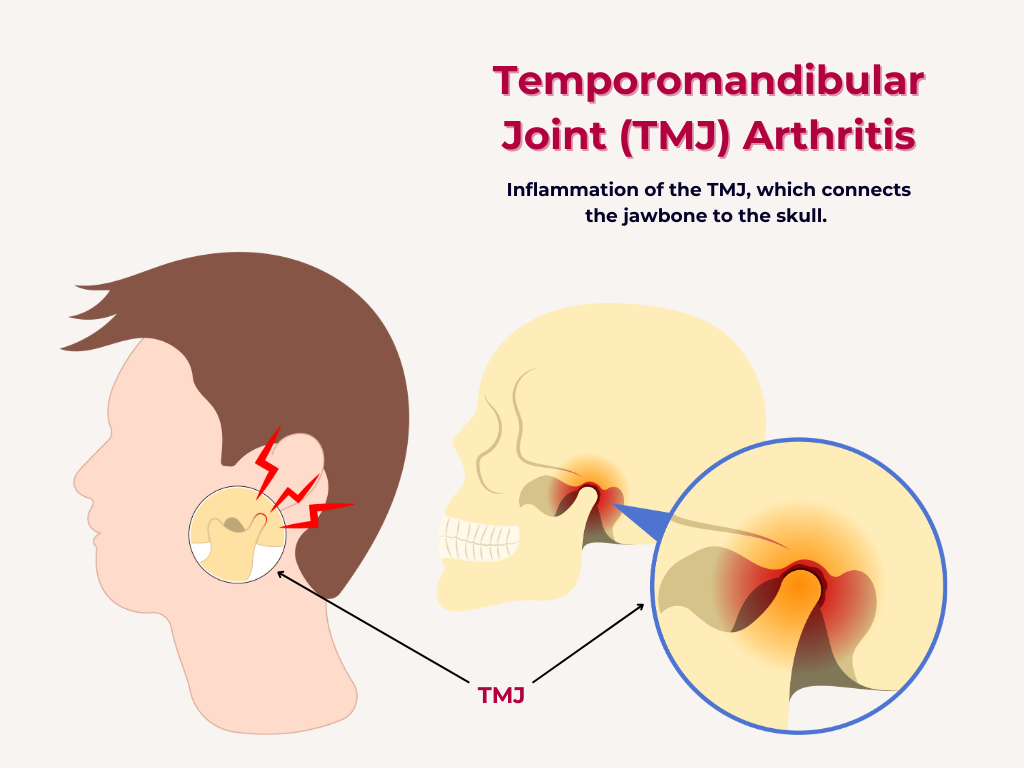Overview
Temporomandibular Joint (TMJ) arthritis refers to inflammation of the temporomandibular joint, which connects the jawbone to the skull. TMJ arthritis condition is characterized by inflammation and degeneration of the temporomandibular joint, leading to pain, stiffness, and limited mobility.
Epidemiology
TMJ disorders, including arthritis, affect millions of people worldwide. Women are more likely to experience TMJ issues than men, and the condition often affects individuals between 20 and 40 years old.
Pathophysiology
The exact cause of TMJ arthritis is unclear, but contributing factors include :
1. Wear and tear: Degeneration of joint cartilage due to aging or overuse.
2. Autoimmune disorders: Conditions like rheumatoid cool arthritis, where the immune system attacks healthy joint tissue.
3. Injury: Trauma to the jaw or joint.
4. Genetics: Family history may play a role.
Symptoms
Symptoms and signs
1. Pain: Aching or tenderness in the jaw, face, or temples
2. Stiffness: Limited mobility or clicking sounds when opening or closing the mouth
3. Swelling: Inflammation or redness around the joint
4. Clicking or popping: Sounds when moving the jaw
5. Locking: Difficulty opening or closing the mouth
Investigations
1. Physical examination: Evaluating jaw mobility, tenderness, and clicking sounds.
2. Imaging tests: X-rays, CT scans, or MRI scans to assess joint damage.
3. Blood tests: To rule out other conditions or detect inflammatory markers.
Complications
1. Chronic pain: Persistent discomfort or limited mobility
2. Joint damage: Degeneration or erosion of joint cartilage and bone
1. Limited mobility: Reduced range of motion or locking of the jaw
Management
Medical Management
1. Pain relievers: Over-the-counter medications like acetaminophen or ibuprofen
2. Anti-inflammatory medications: To reduce swelling and pain
3. Muscle relaxants: To alleviate muscle tension
4. Corticosteroid injections: To reduce inflammation
Surgical Management
1. Arthrocentesis: A minimally invasive procedure to remove inflammatory byproducts
2. Arthroscopy: A surgical procedure to examine and treat joint damage
3. Joint replacement: Replacing the damaged joint with an artificial one
Lifestyle Changes
1. Jaw exercises: To improve mobility and strength
2. Dietary modifications: Avoiding hard or chewy foods
3. Stress management: Techniques to reduce tension and clenching
4. Physical therapy: To improve jaw mobility and reduce pain.
Share Post On:
Recent Posts
-
Nuggets of ORL-RHINOLOGY
-
Nuggets of Otorhinolaryngology-Basic sciences
-
Anatomy of the Muscles of the Soft Palate
-
Ethmoidal Arteries Ligation for Epistaxis
-
Submucous Cleft Palate (SMCP)
-
Approach to Ligation of the External Carotid Artery
-
Approach to Managing a 3-Year-Old Boy with a Foreign Body in the nasal cavity.
-
Approach to Managing a 3-Year-Old Boy with a Foreign Body impacted in the ear canal.
-
Endoscopic Sphenopalatine Artery Ligation (ESPAL) for Epistaxis
-
Surgical Management of Epistaxis
-
Technique of Incision and Drainage of Septal Hematoma/Septal Abscess
-
Upper Aerodigestive Tract Foreign Body Impaction
-
Incision and Drainage of Hematoma Auris
-
Rigid Bronchoscopy for Retrieval of Foreign Bodies in Children
-
Foreign Body Impaction in the Larynx, Trachea, and Bronchi
-
Leadership Position is a Tool, not a Trophy
-
Carcinoma of the Oropharynx
-
Peritonsillar Abscess
-
Ethics of Doctor-Patient Relationship
-
Doctor-Patient Relationship Case Scenarios
-
Asymmetrical Tonsils and Approach to Evaluation and Management
-
Nasal Polyposis
-
Rigid Oesophagoscopy and Complication
-
Anatomy of Oesophagus
-
Stridor, Snoring, Stertor And Wheezing: How They Compare
-
Temporomandibular Joint (TMJ)
-
Otoacoustic Emissions
-
Tympanometry
-
Functional Endoscopic Sinus Surgery (FESS)
-
Tracheostomy
Categories
RELATED POSTS
Get in Touch
Read doctor-produced health and medical information written for you to make informed decisions about your health concerns.


